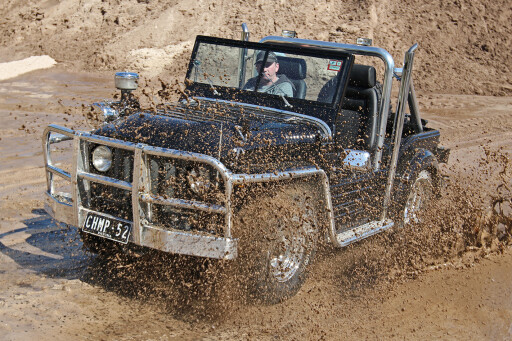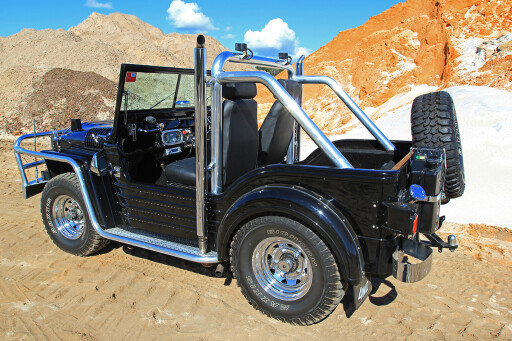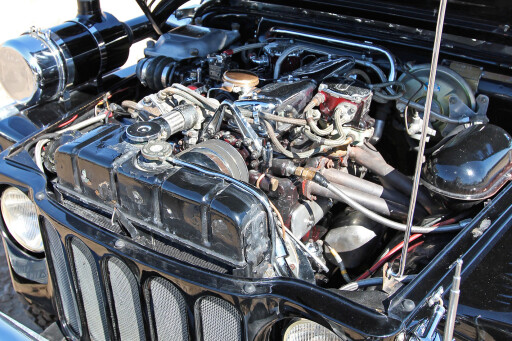
FEW vehicles can claim the history of Warren Carswell’s Austin Champ.
This article was originally published in the March 2014 issue of 4x4 Australia
Designed by the British as a specialist military combat vehicle, it survived its early service years dodging bullets in Papua New Guinea before retiring in 1964 and finding its way to Townsville, Australia.
 “I scored it as a company car in a carpet-laying business. As an 18-year-old, it was pretty cool. It was the only one of its kind around at the time, so it would always score plenty of attention on the street, with many people mistaking it for an FJ40,” Warren said.
“I scored it as a company car in a carpet-laying business. As an 18-year-old, it was pretty cool. It was the only one of its kind around at the time, so it would always score plenty of attention on the street, with many people mistaking it for an FJ40,” Warren said.
Built to replace the US-sourced Jeep, the design followed similar cues with a ute-styled four seater body of welded pressed steel panels and a vertical five-slot grille. A distinguishing factor was the bull-nosed hood with ribbed ventilation flares on each side.
The restoration project began in the 1990s and extended over 16 years. This wasn’t helped by Warren’s deteriorating health at the time.
“Fearing the worst, I gave up work and committed myself to getting the restoration done. With parts continually rolling up at the door, purchased both locally and overseas, it almost felt like Christmas. It was a great sense of achievement seeing it finally come together after such an extended time frame,” Warren said.
 During the latter course of the project, Warren’s health took an unexpected turn for the better, suggesting the distraction of the rebuild had done him wonders.
During the latter course of the project, Warren’s health took an unexpected turn for the better, suggesting the distraction of the rebuild had done him wonders.
The first things to go during the rebuild were the tall and skinny military spec wheels and the large fold-up snorkel. Wide chrome wheels with Maxxis Bighorn rubber were called into duty, requiring some modification to pump out the rear flares, and a Donaldson air cleaner was mated to an externally mounted barrel to help source clean air.
Providing some front and side protection, a large aluminium bullbar with side rails and steps dominates the front view, disguising the unique lines of the Champ. It doesn’t endear an enviable approach angle, acting more like a sand plough during our photo shoot, but it’s clearly evident from the big tyres and limited clearance under the guards that the project wasn’t geared to mountain goat specifications.
 Even so, the independent suspension runs out of wheel travel relatively quickly and, with open diffs at each end, it’s not the best performer on slow lumpy terrain, relying heavily on momentum to get the job done. A crawler first gear is used in place of low range and is rarely used for everyday driving.
Even so, the independent suspension runs out of wheel travel relatively quickly and, with open diffs at each end, it’s not the best performer on slow lumpy terrain, relying heavily on momentum to get the job done. A crawler first gear is used in place of low range and is rarely used for everyday driving.
Rust was removed and the body was cleaned up, primed and repainted in a brilliant black duco, complemented by chrome highlights, including big exhaust stacks. But the latter proved a little problematic when the Champ was hired for weddings, as the light smattering of exhaust particles wasn’t particularly conducive to happy wedding parties. Instead, it was re-routed under the vehicle using a stainless steel system. The stacks were left in place.
Taking care of suspension, the torsion bar independent system is largely unchanged, assisted by Bilstein shock absorbers on each corner. The Rolls Royce engine is unmodified and retains the same compression since rolling off the production line. With a 24-volt electrical system, the engine readily fires to life and, once warm, it settles into a low 400rpm idle.
 The interior is much more welcoming with the addition of a pair of leather Recaro seats and soft-feel marine carpet on both the floor and walls. The bus-like steering wheel was also retired in favour of an SAAS number with chrome inserts, matching the gear stick and other decorative touches. Between the seats, a gate for the shifter can select forward or reverse gearing, or the power take-off (PTO) winch.
The interior is much more welcoming with the addition of a pair of leather Recaro seats and soft-feel marine carpet on both the floor and walls. The bus-like steering wheel was also retired in favour of an SAAS number with chrome inserts, matching the gear stick and other decorative touches. Between the seats, a gate for the shifter can select forward or reverse gearing, or the power take-off (PTO) winch.
Instrumentation is original with a large central cluster showing RPM, coolant temperature, fuel, MPH, an odometer and a trip meter.
The standard instrumentation is waterproof, with some switchgear provided with waterproof caps, which were screwed on prior to any deep water crossings. To finish it off, a large alloy rollbar provides additional street cred.
 With permission from the landowner, we toiled around a local quarry amongst massive earthmoving machinery during the course of our photo shoot, climbing mountains of sand and looking for the ultimate photo op.
With permission from the landowner, we toiled around a local quarry amongst massive earthmoving machinery during the course of our photo shoot, climbing mountains of sand and looking for the ultimate photo op.
We had been warned of a feral goat which policed the grounds, but he kept his distance for the duration of events, only taking interest when the highly polished Champ hit the water course; otherwise known as a big brown puddle. It was interesting watching the goat peer down from the highest peak at the antics below.
 A Google search indicates Champs still pop up for sale in various forums and classifieds; although, there was nothing for sale locally at the time. It seems a trip to the UK would be the best bet for well-heeled enthusiasts keen to get in on some Champ action.
A Google search indicates Champs still pop up for sale in various forums and classifieds; although, there was nothing for sale locally at the time. It seems a trip to the UK would be the best bet for well-heeled enthusiasts keen to get in on some Champ action.
Tallying the costs revealed a project spend of more than $80,000. While traditionalist Chapmen (Champ owners) will cringe at Warren’s creation, to the average guy or gal on the street, it’s a very sweet looking ride.
HISTORY OF THE CHAMP
THE Austin Champ was produced between 1951-56 following a number of prototypes built under tender, with a long list of contributing manufacturers. The official name was an FV1801A Truck, quarter tonne, CT/GS (combat truck/general service) with ambulance, cable laying or gun-mount versions.
There was also an FV1802A Truck, quarter or half tonne, offered in utility or civilian builds, the latter without the Rolls Royce engine and expensive waterproofing. The FV was short for Fighting Vehicle.
Part of the development included studies into the rationalisation of equipment and powertrains to reduce the inventory of parts held. Studies revealed an inventory of 3000 parts would be required based on the various types of equipment and transport in use at that time.
 Instead, it was proposed to rationalise that list, manufacturing a premium range of four-, six- and eight-cylinder petrol engines to service a broad range of military equipment. In this case, inventory would drop to 300 parts. The answer to that study was the Rolls Royce B40, B60 and B80 engines, with the B40 finding its way into the Champ.
Instead, it was proposed to rationalise that list, manufacturing a premium range of four-, six- and eight-cylinder petrol engines to service a broad range of military equipment. In this case, inventory would drop to 300 parts. The answer to that study was the Rolls Royce B40, B60 and B80 engines, with the B40 finding its way into the Champ.
The Austin Motor Company eventually won the contract to produce 15,000 Champs, powered by the single overhead cam, inline four-cylinder petrol B40 unit of 2838cc capacity, producing 60kW at 3750rpm and 199Nm at 1750rpm.
While Rolls Royce originally manufactured the engines, it was unable to maintain the supply, with tooling passed to Austin to manufacture under license to help stem demand. The engine, transmission and driveline were all fully sealed to sustain water crossings of up to two metres with a fold-up extendable snorkel.
 The transmission offered five synchromesh gears in forward and reverse, with a top speed of 104km/h.
The transmission offered five synchromesh gears in forward and reverse, with a top speed of 104km/h.
A transfer box allowed the selection of two- or four-wheel drive and longitudinal torsion bars provided the springing for the fully independent suspension at each end. A 24-volt electrical system helped motivate the large pistons into life, and an adapter for the alternator facilitated welding in the field.
Common military accessories included a shovel and pickaxe mounted on the side of the vehicle, a carrier for a standard 20-litre water jerry can at the rear, and a forward-folding windscreen to accommodate a machine gun using a built-in pintle mount.
 At a cost of 1200 pounds in 1952, the Champ eventually lost favour and was considered too complex and expensive. Maintenance costs were also considerable and, when left unattended, it was considered unreliable for front line work. As a result, the contract with Austin was terminated 4000 units short of its 15,000 target. The Australian Army purchased 400 units.
At a cost of 1200 pounds in 1952, the Champ eventually lost favour and was considered too complex and expensive. Maintenance costs were also considerable and, when left unattended, it was considered unreliable for front line work. As a result, the contract with Austin was terminated 4000 units short of its 15,000 target. The Australian Army purchased 400 units.
The Land Rover was its successor, said to be available for half the price yet still able to do most of that of the Champ. With that said, the Champ will go down in history as a unique, high calibre vehicle, built from the ground up for specialist military work.
It is even more amazing when you consider it was spawned in the 1950s, with fully independent suspension at each end, rack and pinion steering, 104km/h capability in forward or reverse, and that magnificent fully sealed Rolls Royce engine.
References: Austin Champ, the first 60 years, Gus Gowers.
AUSTIN CHAMP OWNERS CLUB (ACOC)
FOR anyone seeking further information on the Champ, the UK-based Austin Champ Owners’ Club is a good place to start, with regional contacts in Australia, UK, Italy, US, Holland and South Africa.
According to ACOC Australian contact, Rose Altmann, “There isn’t an Australian Club, just a loose network of Champ enthusiasts. Each year, someone volunteers to arrange a Champ Camp in a different place. So far we’ve ventured to Victoria, Tasmania and New South Wales, with each event offering four-wheel driving and social activities. Occasionally we have overseas visitors participating.”
.jpg ) The Austin Champ Owners’ Club website includes information on identifying your Champ using the chassis and engine numbers and where to find them. An owner’s register contains information on vehicles that have been previously registered, for those that are researching information on used buys.
The Austin Champ Owners’ Club website includes information on identifying your Champ using the chassis and engine numbers and where to find them. An owner’s register contains information on vehicles that have been previously registered, for those that are researching information on used buys.
Members have access to the club magazine, register and forum.
For more information go to: www.austinchamp.com

COMMENTS